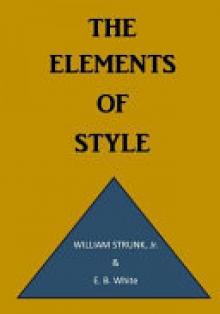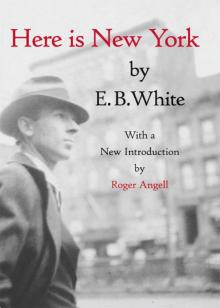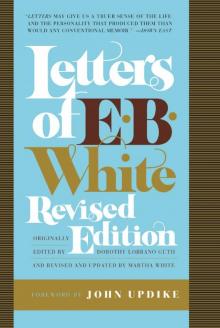- Home
- E. B. White
The Elements of Style
The Elements of Style Read online
The
ELEMENTS
of
STYLE
BY
WILLIAM STRUNK Jr.
With Revisions, an Introduction, and a Chapter on Writing
BY
E. B. WHITE
F O U R T H EDITION
* * *
[Note on scan -- Left in this text when refering to the actual text means the top, Right means the bottom:
The log was partially submerged. (Top and Left)
The log was partly submerged. (Bottom andRight)
This is consistant throughout the text.]
* * *
Contents
FOREWORD
INTRODUCTION
I. ELEMENTARY RULES OF USAGE
1. Form the possessive singular of nouns by adding 's.
2. In a series of three or more terms with a single conjunction, use a comma after each term except the last.
3. Enclose parenthetic expressions between commas.
4. Place a comma before a conjunction introducing an independent clause.
5. Do not join independent clauses with a comma.
6. Do not break sentences in two.
7. Use a colon after an independent clause to introduce a list of particulars, an appositive, an amplification, or an illustrative quotation.
8. Use a dash to set off an abrupt break or interruption and to announce a long appositive or summary.
9. The number of the subject determines the number of the verb.
10. Use the proper case of pronoun.
11. A participial phrase at the beginning of a sentence must refer to the grammatical subject.
II. ELEMENTARY PRINCIPLES OF COMPOSITION
12. Choose a suitable design and hold to it.
13. Make the paragraph the unit of composition.
14. Use the active voice.
15. Put statements in positive form.
16. Use definite, specific, concrete language.
17. Omit needless words.
18. Avoid a succession of loose sentences.
19. Express coordinate ideas in similar form.
20. Keep related words together.
21. In summaries, keep to one tense.
22. Place the emphatic words of a sentence at the end.
III. A FEW MATTERS OF FORM
IV. WORDS AND EXPRESSIONS COMMONLY MISUSED
V. AN APPROACH TO STYLE (With a List of Reminders)
1. Place yourself in the background.
2. Write in a way that comes naturally.
3. Work from a suitable design.
4. Write with nouns and verbs.
5. Revise and rewrite.
6. Do not overwrite.
7. Do not overstate.
8. Avoid the use of qualifiers.
9. Do not affect a breezy manner.
10. Use orthodox spelling.
11. Do not explain too much.
12. Do not construct awkward adverbs.
13. Make sure the reader knows who is speaking.
14. Avoid fancy words.
15. Do not use dialect unless your ear is good.
16. Be clear.
17. Do not inject opinion.
18. Use figures of speech sparingly.
19. Do not take shortcuts at the cost of clarity.
20. Avoid foreign languages.
21. Prefer the standard to the offbeat.
AFTERWORD
GLOSSARY
COPYRIGHT
SCAN & PROOF NOTES
* * *
Foreword
by Roger Angell
The first writer I watched at work was my stepfather, E. B. White. Each Tuesday morning, he would close his study door and sit down to write the "Notes and Comment" page for The New Yorker. The task was familiar to him—he was required to file a few hundred words of editorial or personal commentary on some topic in or out of the news that week—but the sounds of his typewriter from his room came in hesitant bursts, with long silences in between. Hours went by. Summoned at last for lunch, he was silent and preoccupied, and soon excused himself to get back to the job. When the copy went off at last, in the afternoon RFD pouch—we were in Maine, a day's mail away from New York—he rarely seemed satisfied. "It isn't good enough," he said sometimes. "I wish it were better."
Writing is hard, even for authors who do it all the time. Less frequent practitioners—the job applicant; the business executive with an annual report to get out; the high school senior with a Faulkner assignment; the graduate-school student with her thesis proposal; the writer of a letter of condolence—often get stuck in an awkward passage or find a muddle on their screens, and then blame themselves. What should be easy and flowing looks tangled or feeble or overblown—not what was meant at all. What's wrong with me, each one thinks. Why can't I get this right?
It was this recurring question, put to himself, that must have inspired White to revive and add to a textbook by an English professor of his, Will Strunk Jr., that he had first read in college, and to get it published. The result, this quiet book, has been in print for forty years, and has offered more than ten million writers a helping hand. White knew that a compendium of specific tips—about singular and plural verbs, parentheses, the "that"-"which" scuffle, and many others—could clear up a recalcitrant sentence or subclause when quickly reconsulted, and that the larger principles needed to be kept in plain sight, like a wall sampler.
How simple they look, set down here in White's last chapter: "Write in a way that comes naturally." "Revise and rewrite." "Do not explain too much," and the rest; above all, the cleansing, clarion "Be clear." How often I have turned to them, in the book or in my mind, while trying to start or unblock or revise some piece of my own writing! They help—they really do. They work. They are the way.
E. B. White's prose is celebrated for its ease and clarity— just think of Charlotte's Web—but maintaining this standard required endless attention. When the new issue of The New Yorker turned up in Maine, I sometimes saw him reading his "Comment" piece over to himself, with only a slightly different expression than the one he'd worn on the day it went off. Well, O.K., he seemed to be saying. At least I got the elements right.
This edition has been modestly updated, with word processors and air conditioners making their first appearance among White's references, and with a light redistribution of genders to permit a feminine pronoun or female farmer to take their places among the males who once innocently served him. Sylvia Plath has knocked Keats out of the box, and I notice that "America" has become "this country" in a sample text, to forestall a subsequent and possibly demeaning "she" in the same paragraph. What is not here is anything about E-mail—the rules-free, lower-case flow that cheerfully keeps us in touch these days. E-mail is conversation, and it may be replacing the sweet and endless talking we once sustained (and tucked away) within the informal letter. But we are all writers and readers as well as communicators, with the need at times to please and satisfy ourselves (as White put it) with the clear and almost perfect thought.
* * *
Introduction *
*E. B. White wrote this introduction for the 1979 edition.
At the close of the first World War, when I was a student at Cornell, I took a course called English 8. My professor was William Strunk Jr. A textbook required for the course was a slim volume called The Elements of Style, whose author was the professor himself. The year was 1919. The book was known on the campus in those days as "the little book," with the stress on the word "little." It had been privately printed by the author.
I passed the course, graduated from the university, and forgot the book but not the professor. Some thirty-eight years later, the book bobbed up again in my life when Mac-millan commissioned me
to revise it for the college market and the general trade. Meantime, Professor Strunk had died.
The Elements of Style, when I reexamined it in 1957, seemed to me to contain rich deposits of gold. It was Will Strunk's parvum opus, his attempt to cut the vast tangle of English rhetoric down to size and write its rules and principles on the head of a pin. Will himself had hung the tag "little" on the book; he referred to it sardonically and with secret pride as "the little book," always giving the word "little" a special twist, as though he were putting a spin on a ball. In its original form, it was a forty-three page summation of the case for cleanliness, accuracy, and brevity in the use of English. Today, fifty-two years later, its vigor is unimpaired, and for sheer pith I think it probably sets a record that is not likely to be broken. Even after I got through tampering with it, it was still a tiny thing, a barely tarnished gem. Seven rules of usage, eleven principles of composition, a few matters of form, and a list of words and expressions commonly misused—that was the sum and substance of Professor Strunk's work. Somewhat audaciously, and in an attempt to give my publisher his money's worth, I added a chapter called "An Approach to Style," setting forth my own prejudices, my notions of error, my articles of faith. This chapter (Chapter V) is addressed particularly to those who feel that English prose composition is not only a necessary skill but a sensible pursuit as well— a way to spend one's days. I think Professor Strunk would not object to that.
A second edition of the book was published in 1972. I have now completed a third revision. Chapter IV has been refurbished with words and expressions of a recent vintage; four rules of usage have been added to Chapter I. Fresh examples have been added to some of the rules and principles, amplification has reared its head in a few places in the text where I felt an assault could successfully be made on the bastions of its brevity, and in general the book has received a thorough overhaul—to correct errors, delete bewhiskered entries, and enliven the argument.
Professor Strunk was a positive man. His book contains rules of grammar phrased as direct orders. In the main I have not tried to soften his commands, or modify his pronouncements, or remove the special objects of his scorn. I have tried, instead, to preserve the flavor of his discontent while slightly enlarging the scope of the discussion. The Elements of Style does not pretend to survey the whole field. Rather it proposes to give in brief space the principal requirements of plain English style. It concentrates on fundamentals: the rules of usage and principles of composition most commonly violated.
The reader will soon discover that these rules and principles are in the form of sharp commands, Sergeant Strunk snapping orders to his platoon. "Do not join independent clauses with a comma." (Rule 5.) "Do not break sentences in two." (Rule 6.) "Use the active voice." (Rule 14.) "Omit needless words." (Rule 17.) "Avoid a succession of loose sentences." (Rule 18.) "In summaries, keep to one tense." (Rule 21.) Each rule or principle is followed by a short hortatory essay, and usually the exhortation is followed by, or interlarded with, examples in parallel columns—the true vs. the false, the right vs. the wrong, the timid vs. the bold, the ragged vs. the trim. From every line there peers out at me the puckish face of my professor, his short hair parted neatly in the middle and combed down over his forehead, his eyes blinking incessantly behind steel-rimmed spectacles as though he had just emerged into strong light, his lips nibbling each other like nervous horses, his smile shuttling to and fro under a carefully edged mustache.
"Omit needless words!" cries the author on page 23, and into that imperative Will Strunk really put his heart and soul. In the days when I was sitting in his class, he omitted so many needless words, and omitted them so forcibly and with such eagerness and obvious relish, that he often seemed in the position of having shortchanged himself—a man left with nothing more to say yet with time to fill, a radio prophet who had out-distanced the clock. Will Strunk got out of this predicament by a simple trick: he uttered every sentence three times. When he delivered his oration on brevity to the class, he leaned forward over his desk, grasped his coat lapels in his hands, and, in a husky, conspiratorial voice, said, "Rule Seventeen. Omit needless words! Omit needless words! Omit needless words!"
He was a memorable man, friendly and funny. Under the remembered sting of his kindly lash, I have been trying to omit needless words since 1919, and although there are still many words that cry for omission and the huge task will never be accomplished, it is exciting to me to reread the masterly Strunkian elaboration of this noble theme. It goes:
Vigorous writing is concise. A sentence should contain no unnecessary words, a paragraph no unnecessary sentences, for the same reason that a drawing should have no unnecessary lines and a machine no unnecessary parts. This requires not that the writer make all sentences short or avoid all detail and treat subjects only in outline, but that every word tell.
There you have a short, valuable essay on the nature and beauty of brevity—fifty-nine words that could change the world. Having recovered from his adventure in prolixity (fifty-nine words were a lot of words in the tight world of William Strunk Jr.), the professor proceeds to give a few quick lessons in pruning. Students learn to cut the dead-wood from "this is a subject that," reducing it to "this subject," a saving of three words. They learn to trim "used for fuel purposes" down to "used for fuel." They learn that they are being chatterboxes when they say "the question as to whether" and that they should just say "whether"—a saving of four words out of a possible five.
The professor devotes a special paragraph to the vile expression the fact that, a phrase that causes him to quiver with revulsion. The expression, he says, should be "revised out of every sentence in which it occurs." But a shadow of gloom seems to hang over the page, and you feel that he knows how hopeless his cause is. I suppose I have written the fact that a thousand times in the heat of composition, revised it out maybe five hundred times in the cool aftermath. To be batting only .500 this late in the season, to fail half the time to connect with this fat pitch, saddens me, for it seems a betrayal of the man who showed me how to swing at it and made the swinging seem worthwhile.
I treasure The Elements of Style for its sharp advice, but I treasure it even more for the audacity and self-confidence of its author. Will knew where he stood. He was so sure of where he stood, and made his position so clear and so plausible, that his peculiar stance has continued to invigorate me—and, I am sure, thousands of other ex-students—during the years that have intervened since our first encounter. He had a number of likes and dislikes that were almost as whimsical as the choice of a necktie, yet he made them seem utterly convincing. He disliked the word forceful and advised us to use forcible instead. He felt that the word clever was greatly overused: "It is best restricted to ingenuity displayed in small matters." He despised the expression student body, which he termed gruesome, and made a special trip downtown to the Alumni News office one day to protest the expression and suggest that studentry be substituted—a coinage of his own, which he felt was similar to citizenry. I am told that the News editor was so charmed by the visit, if not by the word, that he ordered the student body buried, never to rise again. Studentry has taken its place. It's not much of an improvement, but it does sound less cadaverous, and it made Will Strunk quite happy.
Some years ago, when the heir to the throne of England was a child, I noticed a headline in the Times about Bonnie Prince Charlie: "Charles' tonsils out." Immediately Rule 1 leapt to mind.
1. Form the possessive singular of nouns by adding "s. Follow this rule whatever the final consonant. Thus write,
Charles's friend
Burns's poems
the witch's malice
Clearly, Will Strunk had foreseen, as far back as 1918, the dangerous tonsillectomy of a prince, in which the surgeon removes the tonsils and the Times copy desk removes the final s. He started his book with it. I commend Rule 1 to the Times, and I trust that Charles's throat, not Charles' throat, is in fine shape today.
Style rules of this sort are,
of course, somewhat a matter of individual preference, and even the established rules of grammar are open to challenge. Professor Strunk, although one of the most inflexible and choosy of men, was quick to acknowledge the fallacy of inflexibility and the danger of doctrine. "It is an old observation," he wrote, "that the best writers sometimes disregard the rules of rhetoric. When they do so, however, the reader will usually find in the sentence some compensating merit, attained at the cost of the violation. Unless he is certain of doing as well, he will prob-ablv do best to follow the rules."
It is encouraging to see how perfectly a book, even a dust)- rule book, perpetuates and extends the spirit of a man. Will Strunk loved the clear, the brief, the bold, and his book is clear, brief, bold. Boldness is perhaps its chief distinguishing mark. On page 26, explaining one of his parallels, he says, "The lefthand version gives the impression that the writer is undecided or timid, apparently unable or afraid to choose one form of expression and hold to it." And his original Rule 11 was "Make definite assertions." That was Will all over. He scorned the vague, the tame, the colorless, the irresolute. He felt it was worse to be irresolute than to be wrong. I remember a day in class when he leaned far forward, in his characteristic pose—the pose of a man about to impart a secret—and croaked, "If you don't know how to pronounce a word, say it loud! If you don't know how to pronounce a word, say it loud!" This comical piece of advice struck me as sound at the time, and I still respect it. Why compound ignorance with inaudibility? Why run and hide?
All through The Elements of Style one finds evidences of the author's deep sympathy for the reader. Will felt that the reader was in serious trouble most of the time, floundering in a swamp, and that it was the duty of anyone attempting to write English to drain this swamp quickly and get the reader up on dry ground, or at least to throw a rope. In revising the text, I have tried to hold steadily in mind this belief of his, this concern for the bewildered reader.

 Charlotte's Web
Charlotte's Web Stuart Little
Stuart Little The Elements of Style
The Elements of Style Here Is New York
Here Is New York The Trumpet of the Swan
The Trumpet of the Swan Essays of E. B. White
Essays of E. B. White Writings from the New Yorker 1925-1976
Writings from the New Yorker 1925-1976 Letters of E. B. White
Letters of E. B. White